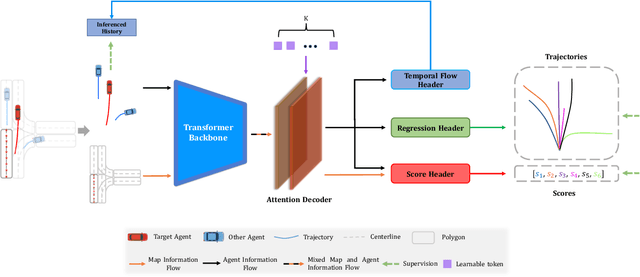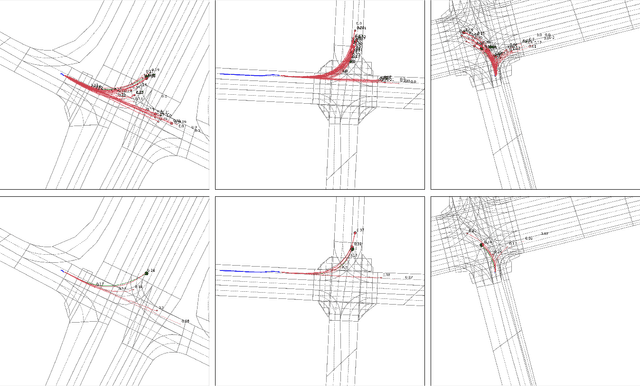Hangning Zhou
Autoregressive Meta-Actions for Unified Controllable Trajectory Generation
May 29, 2025



Abstract:Controllable trajectory generation guided by high-level semantic decisions, termed meta-actions, is crucial for autonomous driving systems. A significant limitation of existing frameworks is their reliance on invariant meta-actions assigned over fixed future time intervals, causing temporal misalignment with the actual behavior trajectories. This misalignment leads to irrelevant associations between the prescribed meta-actions and the resulting trajectories, disrupting task coherence and limiting model performance. To address this challenge, we introduce Autoregressive Meta-Actions, an approach integrated into autoregressive trajectory generation frameworks that provides a unified and precise definition for meta-action-conditioned trajectory prediction. Specifically, We decompose traditional long-interval meta-actions into frame-level meta-actions, enabling a sequential interplay between autoregressive meta-action prediction and meta-action-conditioned trajectory generation. This decomposition ensures strict alignment between each trajectory segment and its corresponding meta-action, achieving a consistent and unified task formulation across the entire trajectory span and significantly reducing complexity. Moreover, we propose a staged pre-training process to decouple the learning of basic motion dynamics from the integration of high-level decision control, which offers flexibility, stability, and modularity. Experimental results validate our framework's effectiveness, demonstrating improved trajectory adaptivity and responsiveness to dynamic decision-making scenarios. We provide the video document and dataset, which are available at https://arma-traj.github.io/.
DRoPE: Directional Rotary Position Embedding for Efficient Agent Interaction Modeling
Mar 19, 2025Abstract:Accurate and efficient modeling of agent interactions is essential for trajectory generation, the core of autonomous driving systems. Existing methods, scene-centric, agent-centric, and query-centric frameworks, each present distinct advantages and drawbacks, creating an impossible triangle among accuracy, computational time, and memory efficiency. To break this limitation, we propose Directional Rotary Position Embedding (DRoPE), a novel adaptation of Rotary Position Embedding (RoPE), originally developed in natural language processing. Unlike traditional relative position embedding (RPE), which introduces significant space complexity, RoPE efficiently encodes relative positions without explicitly increasing complexity but faces inherent limitations in handling angular information due to periodicity. DRoPE overcomes this limitation by introducing a uniform identity scalar into RoPE's 2D rotary transformation, aligning rotation angles with realistic agent headings to naturally encode relative angular information. We theoretically analyze DRoPE's correctness and efficiency, demonstrating its capability to simultaneously optimize trajectory generation accuracy, time complexity, and space complexity. Empirical evaluations compared with various state-of-the-art trajectory generation models, confirm DRoPE's good performance and significantly reduced space complexity, indicating both theoretical soundness and practical effectiveness. The video documentation is available at https://drope-traj.github.io/.
KiGRAS: Kinematic-Driven Generative Model for Realistic Agent Simulation
Jul 17, 2024Abstract:Trajectory generation is a pivotal task in autonomous driving. Recent studies have introduced the autoregressive paradigm, leveraging the state transition model to approximate future trajectory distributions. This paradigm closely mirrors the real-world trajectory generation process and has achieved notable success. However, its potential is limited by the ineffective representation of realistic trajectories within the redundant state space. To address this limitation, we propose the Kinematic-Driven Generative Model for Realistic Agent Simulation (KiGRAS). Instead of modeling in the state space, KiGRAS factorizes the driving scene into action probability distributions at each time step, providing a compact space to represent realistic driving patterns. By establishing physical causality from actions (cause) to trajectories (effect) through the kinematic model, KiGRAS eliminates massive redundant trajectories. All states derived from actions in the cause space are constrained to be physically feasible. Furthermore, redundant trajectories representing identical action sequences are mapped to the same representation, reflecting their underlying actions. This approach significantly reduces task complexity and ensures physical feasibility. KiGRAS achieves state-of-the-art performance in Waymo's SimAgents Challenge, ranking first on the WOMD leaderboard with significantly fewer parameters than other models. The video documentation is available at \url{https://kigras-mach.github.io/KiGRAS/}.
StreamMOTP: Streaming and Unified Framework for Joint 3D Multi-Object Tracking and Trajectory Prediction
Jun 28, 2024Abstract:3D multi-object tracking and trajectory prediction are two crucial modules in autonomous driving systems. Generally, the two tasks are handled separately in traditional paradigms and a few methods have started to explore modeling these two tasks in a joint manner recently. However, these approaches suffer from the limitations of single-frame training and inconsistent coordinate representations between tracking and prediction tasks. In this paper, we propose a streaming and unified framework for joint 3D Multi-Object Tracking and trajectory Prediction (StreamMOTP) to address the above challenges. Firstly, we construct the model in a streaming manner and exploit a memory bank to preserve and leverage the long-term latent features for tracked objects more effectively. Secondly, a relative spatio-temporal positional encoding strategy is introduced to bridge the gap of coordinate representations between the two tasks and maintain the pose-invariance for trajectory prediction. Thirdly, we further improve the quality and consistency of predicted trajectories with a dual-stream predictor. We conduct extensive experiments on popular nuSences dataset and the experimental results demonstrate the effectiveness and superiority of StreamMOTP, which outperforms previous methods significantly on both tasks. Furthermore, we also prove that the proposed framework has great potential and advantages in actual applications of autonomous driving.
SparseAD: Sparse Query-Centric Paradigm for Efficient End-to-End Autonomous Driving
Apr 10, 2024



Abstract:End-to-End paradigms use a unified framework to implement multi-tasks in an autonomous driving system. Despite simplicity and clarity, the performance of end-to-end autonomous driving methods on sub-tasks is still far behind the single-task methods. Meanwhile, the widely used dense BEV features in previous end-to-end methods make it costly to extend to more modalities or tasks. In this paper, we propose a Sparse query-centric paradigm for end-to-end Autonomous Driving (SparseAD), where the sparse queries completely represent the whole driving scenario across space, time and tasks without any dense BEV representation. Concretely, we design a unified sparse architecture for perception tasks including detection, tracking, and online mapping. Moreover, we revisit motion prediction and planning, and devise a more justifiable motion planner framework. On the challenging nuScenes dataset, SparseAD achieves SOTA full-task performance among end-to-end methods and significantly narrows the performance gap between end-to-end paradigms and single-task methods. Codes will be released soon.
MacFormer: Map-Agent Coupled Transformer for Real-time and Robust Trajectory Prediction
Aug 31, 2023Abstract:Predicting the future behavior of agents is a fundamental task in autonomous vehicle domains. Accurate prediction relies on comprehending the surrounding map, which significantly regularizes agent behaviors. However, existing methods have limitations in exploiting the map and exhibit a strong dependence on historical trajectories, which yield unsatisfactory prediction performance and robustness. Additionally, their heavy network architectures impede real-time applications. To tackle these problems, we propose Map-Agent Coupled Transformer (MacFormer) for real-time and robust trajectory prediction. Our framework explicitly incorporates map constraints into the network via two carefully designed modules named coupled map and reference extractor. A novel multi-task optimization strategy (MTOS) is presented to enhance learning of topology and rule constraints. We also devise bilateral query scheme in context fusion for a more efficient and lightweight network. We evaluated our approach on Argoverse 1, Argoverse 2, and nuScenes real-world benchmarks, where it all achieved state-of-the-art performance with the lowest inference latency and smallest model size. Experiments also demonstrate that our framework is resilient to imperfect tracklet inputs. Furthermore, we show that by combining with our proposed strategies, classical models outperform their baselines, further validating the versatility of our framework.
A Rotation Meanout Network with Invariance for Dermoscopy Image Classification and Retrieval
Aug 01, 2022



Abstract:The computer-aided diagnosis (CAD) system can provide a reference basis for the clinical diagnosis of skin diseases. Convolutional neural networks (CNNs) can not only extract visual elements such as colors and shapes but also semantic features. As such they have made great improvements in many tasks of dermoscopy images. The imaging of dermoscopy has no main direction, indicating that there are a large number of skin lesion target rotations in the datasets. However, CNNs lack anti-rotation ability, which is bound to affect the feature extraction ability of CNNs. We propose a rotation meanout (RM) network to extract rotation invariance features from dermoscopy images. In RM, each set of rotated feature maps corresponds to a set of weight-sharing convolution outputs and they are fused using meanout operation to obtain the final feature maps. Through theoretical derivation, the proposed RM network is rotation-equivariant and can extract rotation-invariant features when being followed by the global average pooling (GAP) operation. The extracted rotation-invariant features can better represent the original data in classification and retrieval tasks for dermoscopy images. The proposed RM is a general operation, which does not change the network structure or increase any parameter, and can be flexibly embedded in any part of CNNs. Extensive experiments are conducted on a dermoscopy image dataset. The results show our method outperforms other anti-rotation methods and achieves great improvements in dermoscopy image classification and retrieval tasks, indicating the potential of rotation invariance in the field of dermoscopy images.
TENET: Transformer Encoding Network for Effective Temporal Flow on Motion Prediction
Jun 30, 2022



Abstract:This technical report presents an effective method for motion prediction in autonomous driving. We develop a Transformer-based method for input encoding and trajectory prediction. Besides, we propose the Temporal Flow Header to enhance the trajectory encoding. In the end, an efficient K-means ensemble method is used. Using our Transformer network and ensemble method, we win the first place of Argoverse 2 Motion Forecasting Challenge with the state-of-the-art brier-minFDE score of 1.90.
 Add to Chrome
Add to Chrome Add to Firefox
Add to Firefox Add to Edge
Add to Edge